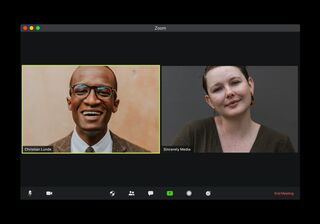Fear
Gust of Screen Fright? Make Online Speaking a Virtual Breeze
Tackle the top five virtual speaking fears.
Posted September 23, 2020

Seventy-three percent of adults have some level of anxiety around speaking in public, according to the National Institute of Mental Health. What about when the public is virtual—possibly colleagues and even strangers in little rectangular frames beamed into your living room? That can come with a whole new surge of agita into your already anxious system.
We recently covered how to boost your confidence and claim your space in the virtual work world. Now, let’s address some of the most common fears about “public speaking” virtually, and what you can do about them.
1. The fear: You will face empty silences. How do you like speaking into a void? A black box? A place where it can feel as if you’re talking to yourself, without the responses you’re used to from in-person interactions? It’s a mind-bender if you think about it, yet online talks in which you’re being recorded have become commonplace—not to mention virtual business meetings in which the only person you can see is yourself while enduring what feels like an awkward silence.
Unlike when you speak to a live audience, when you speak virtually, you often can’t tell whether people are engaged, listening at all, or even present. But this is all par for the virtual speaking course.
The fix: Recruit a cohost or other attendee as a “co-pilot” in advance. You could agree that in the case of an awkward silence, they’ll pipe up with just-in-time questions or comments—any of which you can even “plant” in advance. You can also use the chat feature, games, riddles, quick quizzes, and in some cases even virtual breakout rooms to bring your audiences to life.
Remind yourself why you are speaking virtually to this group in the first place. You bring value, and people want to hear what you have to say. Their silence has no bearing on that. They might be completely engaged, taking notes, and enjoying your talk. What good does it do to assume the opposite?
Also, reframe your fear of public speaking into excitement; research shows that it works and even helps your performance. To counterbalance the trash talk that might go through your ears, tell yourself you’re excited about tackling this challenge. Yes, your words count—even what you say just silently to yourself.
2. The fear: You will bore people. I’m often amazed how many highly accomplished coaching clients of mine, across multiple disciplines and industries, have mentioned their fear of boring their audiences—and that is only compounded online. With fewer cues than in an in-person setting, unless you have grand self-regard, you may worry that you’re not as fascinating as you’d like to be. And how will you know without those visual cues? Maybe you’re used to reading your audience by scanning a room. That’s hard to do when all you can scan is a checkerboard of thumbnail images—some with live faces, some with headshots, and some with just real or virtual backgrounds because the live faces stepped away. So how can you reassure yourself your attendees are listening?

The fix: The first step is to open strong. It’s easier to keep people engaged from the beginning than it is to catch them in the middle. Open with a story, a provocative statement, a surprising statistic, or even a poll to take the audience’s pulse. This signals that your talk is worth paying attention to from the get-go.
Along the way, make the experience visually and auditorily engaging by including interaction points in which the audience can provide feedback, comments, or questions. Consider including elements such as video, music, or trivia questions. But be tech aware—if you can’t pull them off smoothly, it’s best not to do them at all.
If it’s appropriate for your setting, add some humor too, but remember to never put down your workplace or coworkers, and avoid politics and other sensitive topics. Leave time for audience input by building in check-in points. Keep your content snappy by chunking it down into bite-sized pieces. Include breaks, even brief ones so your audience doesn’t get video-conference fatigue.
3. The fear: Something might go wrong during your presentation. We’ve all seen it happen: A colleague is in the middle of an important presentation when suddenly their sound or video cuts out, a cat climbs onto their head, or their little ones blast out from closed doors for a spirited food fight. These types of interferences are common, yet when you’re the presenter, trying to anticipate everything that could go wrong can cause you a lot of anxiety. So how do you plan to stay cool when, inevitably, something will go wrong while all eyes are on you?
The fix: It’s not possible to prevent all of the unwanted surprises that may happen — that’s why they’re surprises. However, it is entirely possible to prepare sufficiently so anything that might arise can be handled smoothly and professionally. This is another instance in which lining up someone to assist you beforehand can be a lifesaver. Is there someone in your home who can be on child or companion-animal duty? Is there a team member you can designate as an alternate host in case your internet cuts out? Set up back-up plans to thwart the blow of Murphy’s Law.
The other part of handling these moments is simply playing it cool, and that comes with practice. If your beagle starts howling, it will more likely be a big deal if you turn it into one. Make a passing comment or a light-hearted joke, take a break if you need to put Rocky in another room, and move on. These situations are often only as disruptive as you allow them to be.
4. The fear: You will be put on the spot. What if someone asks you a question that you don’t know the answer to? Or maybe you’ll lose track of your place on your notes and have to improvise? And since many virtual meetings are recorded on video, the fear is compounded by knowing your missteps will be preserved, replayed, and even shared in perpetuity.
The fix: This is one case in which you have a distinct advantage by speaking virtually, since you can have as many notes and Post-its around you as you need, and nobody will notice. Take plenty of time to arrange your space beforehand, and you’ll be ready for almost anything.
If you get a wildly challenging question during a Q&A, take a deep breath and comment on the question, ask a clarifying question before answering, or even first ask if anyone else would like to share their thoughts before you chime in. Also, you can say, “What a compelling question. I’d like to do a little research on that and get back to you. My initial thought is….” These moments are what you make of them. If this is something you struggle with regularly, take an improv class—a wonderful way to hone your impromptu speaking skills. I recommend that particularly for introverts, who prefer to gather their thoughts before sharing them. Improv helps you build the skills to find a positive way to answer most questions confidently. You’ll do so by fortifying your trust in yourself and your ability to work with cues you get from others.
5. The fear: People will judge your personal and home appearance. While no one is expecting a set from Oprah or the backdrop of the actual Rockies outside your window, you still may be concerned that colleagues will judge the appearance of your home. Even if the clutter around you is your roommates’ or partner’s, you don’t want to be judged for it. And how are you supposed to dress for more formal meetings? Keep in mind that you’re probably not the only one in business casual on top with lounging casual below that.
The fix: Even if your home environment isn’t ideal, you can take a few simple steps to allay your concerns. Most importantly, set up your seating and videocam exactly how you want them well before you’re “on”—not just a minute beforehand.
If you have a lot of background distractions in your home, aim to find or clear a blank spot of wall behind you. You don’t need professional lighting to improve your appearance either. A desk or floor lamp on each side of you will do the trick. Just put them in front of you.

Either go with artificial light (with your shades, blinds, or curtains drawn) or natural light—but probably not a mix of the two. If you have to sit in front of things, remove personal effects, such as political paraphernalia, religious items, and private photos, from view.
If you happen to have a souped-up computer or access to one, you can even buy a green screen (my favorite model attaches to a desk chair and folds up for storing under a bed) and use a virtual background. You can find endless options, many for free, online. Again, simplicity is key. Avoid whiz-bang backgrounds that will distract your audience; you should be the focus, not what’s behind you.
A final thought
All these fears and fixes notwithstanding, we live in a time in which many people are more understanding since we’re all facing a new level of anxiety. So do a little internal work to reframe your thinking. Believe that your virtual audiences are there to enjoy and learn from you, not to give you a hard time. Doing a little external work to set the “stage” will calm your nerves and transform that next gust of screen fright into a virtual breeze.
Copyright @ 2020 Nancy Ancowitz




